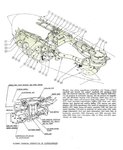MIflyer
1st Lieutenant
Also realize that the two stage supercharged Merlin used mainly an Aftercooler, but also used a partial Intercooler by the way they routed the coolant internal to the engine.
It is amazing that the two stage supercharged Merlin began as a quick lash up, using the Merlin engine, which was already deemed too small for front line fighters, combined with the first stage supercharger from the failed Vulture engine and a stroke of real brilliance, the liquid cooled aftercooler, Note that Stanley Hooker was a theoretical aerodynamicist, and "not much of an engineer" so seizing liquid cooling as an answer was stepping outside his comfort zone.
See the attached article.
It is amazing that the two stage supercharged Merlin began as a quick lash up, using the Merlin engine, which was already deemed too small for front line fighters, combined with the first stage supercharger from the failed Vulture engine and a stroke of real brilliance, the liquid cooled aftercooler, Note that Stanley Hooker was a theoretical aerodynamicist, and "not much of an engineer" so seizing liquid cooling as an answer was stepping outside his comfort zone.
See the attached article.
Attachments
Last edited:

